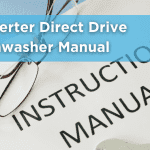Table of Contents
Experiencing issues with your Bosch dishwasher not heating up can be frustrating, especially when it affects the appliance’s cleaning efficiency. This guide is designed to help you troubleshoot and resolve heating issues in your Bosch dishwasher.
Common Causes and Solutions
Step 1: Check the Water Heater Settings
Objective:
Ensure your home’s hot water tank is set at the ideal temperature for your dishwasher.
Steps:
- Locate Your Hot Water Tank: This is usually found in a utility room or basement.
- Check Temperature Setting: The temperature dial should be around 120 degrees Fahrenheit.
- Why 120 Degrees? This temperature is perfect for dissolving dishwasher detergent efficiently and ensures effective cleaning of your dishes.
Step 2: Power and Circuit Breaker
Objective:
To ensure electrical safety before starting any troubleshooting on your dishwasher.
Steps:
- Locate Your Home’s Circuit Breaker Box: This is usually in a basement, garage, or utility area.
- Find the Switch for the Dishwasher: It should be labelled.
- Turn Off the Power: Flip the switch to the ‘Off’ position to cut power to the dishwasher.
Step 3: Inspect the Heating Element
Objective:
To check for any physical damage to the dishwasher’s heating element.
Steps:
- Open Your Dishwasher: Ensure it’s empty for easy access.
- Find the Heating Element: It’s typically located at the bottom of the dishwasher.
- Look for Damage: Check for signs like cracks, chips, or burnt areas.
- Visible Damage Means: The element must be replaced if you see any damage. Check Heating Elements on amazon.
Step 4: Test the Heating Element
Objective:
To verify whether the heating element is functioning properly.
Steps:
- Disconnect the Element: Carefully unhook the heating element from its electrical connections.
- Prepare Multimeter: Set your multimeter to the ohm (Ω) setting.
- Test the Element: Touch the multimeter probes to the terminals of the heating element.
- Read the Results: If the multimeter shows zero or the reading keeps changing, the element might be defective and should be replaced. Check Heating Elements on amazon.
Step 5: Check the Float Switch
Objective:
Ensure the dishwasher is filled with the correct amount of Water for heating.
Steps:
- Start a Rinse Cycle: Let the dishwasher begin a normal rinse cycle.
- Add Water Manually: Carefully pour 1 litre of Water into the dishwasher.
- Observe the Result: If the dishwasher heats the Water after adding more, the float switch (which controls the water level) might be the issue. Find a new float switch to replace.
When to Replace Parts
- Heating Element: If tests confirm the heating element is faulty, consider replacing it. Depending on the model, replacement costs vary.
- Control Circuit Board: If the heating element is functioning correctly, the issue might be with the control circuit board. May require professional diagnosis and replacement.
Video Guide for Reference
For a more visual guide, check out this general video on how to check the heater:
Additional Tips
- Model Specific Information: Always refer to your specific Bosch dishwasher model for more tailored troubleshooting.
- Professional Assistance: If unsure, it’s wise to consult a professional technician for repairs.
Drying Related Problems
- Overcrowded Dishes: Ensure sufficient space for air circulation.
- Unloading Order: Unload the bottom rack first to prevent water spillage onto dry dishes.
- Inefficient Drying Cycle: Select “extra dry” or other powerful drying options.
- Rinse Aid Usage: Regularly fill the rinse aid dispenser to aid in drying.
- Plastic Items: These may retain less heat; adjust the cycle accordingly.
- Vent Issues: Check for and resolve any issues with the vent system.
- Turbidity Sensor: If faulty, consider replacing it.
- Vent Fan Motor: Repair or replace if not functioning correctly.
- Wire Harness: Ensure all connections are secure and undamaged.
- Heated Dry Selection: Choose cycles with a heated dry option for better results.
- Float Switch: Replace if found to be defective.
- High Limit Thermostat: Check and replace if malfunctioning.
- Control Module: Get a professional inspection and replacement if needed.
- Control Board: Consider professional inspection and potential replacement.
- Timer: If malfunctioning, professional inspection is advised.
Conclusion
If your Bosch dishwasher is not heating water efficiently, it’s essential to diagnose the problem accurately. Whether it’s a faulty heating element, a level switch issue, or a problem with the control board, identifying the root cause is key to effective resolution. Remember to exercise caution and seek professional help if needed.




